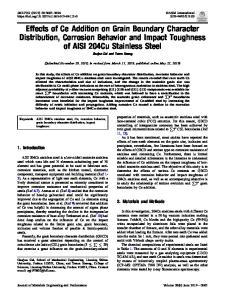Effect of Grain Boundary Character Distribution on the Impact Toughness of 410NiMo Weld Metal
- PDF / 5,883,858 Bytes
- 15 Pages / 593.972 x 792 pts Page_size
- 9 Downloads / 346 Views
TRODUCTION
THE ER410NiMo filler wire was used for welding of martensitic stainless steels. It is also a recommended filler wire for repair welding of turbine shrouds made of AISI 410 martensitic steel.[1,2] The composition of this filler wire falls under soft martensitic stainless steel due to its low carbon content (0.02 wt pct). Second-stage postweld heat treatment (PWHT) is recommended in the codes and standards for this steel to obtain adequate tensile strength and toughness.[1] However, employment of in situ second-stage PWHT in repair-welded martensitic steel turbine components is a complex issue because the surrounding components are also heated up. Moreover, repeated heating and cooling results in additional concern regarding the structural integrity of the equipment. First-stage PWHT is commonly performed between Ac1 and Ac3 transformation temperature of the weld metal which results in tempering of martensite and formation of fresh austenite. While cooling, transformed austenite transforms into martensite.
M. DIVYA, Scientific Officer E, S.K. ALBERT, Scientific Officer H+, Head, and A.K. BHADURI, Distinguished Scientist, Group Director, are with Materials Joining Section, Materials Technology Division, Materials Development and Technology Group, Indira Gandhi Centre for Atomic Research, Kalpakkam, Tamilnadu, 603102, India. C.R. DAS, Postdoctoral, Marie Curie Fellow, formerly with Materials Joining Section, Materials Technology Division, Materials Development and Technology Group, Indira Gandhi Centre for Atomic Research, is now with Materials and Surface Engineering, Department of Mechanical Engineering, Technical University Denmark, 2800, Kgs. Lyngby, Denmark. Contact e-mail: crdas@mek. dtu.dk SANDIP GHOSH CHOWDHURY, Senior Principal Scientist, is with National Metallurgical Laboratory, Jamshedpur, India. Manuscript submitted June 4, 2015. Article published online May 12, 2016 METALLURGICAL AND MATERIALS TRANSACTIONS A
Second-stage PWHT is performed below the Ac1 transformation temperature to ensure tempering of fresh martensite, which forms during the cooling cycle of first-stage PWHT. The volume fraction of retained austenite in the weld metal varies after first- and second-stage PWHT. It is always higher when PWHT is performed below the Ac1 transformation temperature than above that temperature. Therefore, adequate mechanical properties in this type of steel depend on the choice of PWHT temperature and time.[3–5] Tamura et al.[6] reported the change in crystallite size and number fraction of ultrafine crystalline grains formed during PWHT. Divya et al. reported refinement of grains during long PWHT at second stage.[5] It has been reported that the high-angle grain boundary (HAGB) increases the resistance to crack growth in low-alloy bainitic steels.[7] A quantitative study of the boundary characteristics is now possible with less difficulty than in the past with the advent of orientation imaging microscopy (OIM) using the electron backscattered diffraction (EBSD) technique. Many review articles are available on this
Data Loading...










